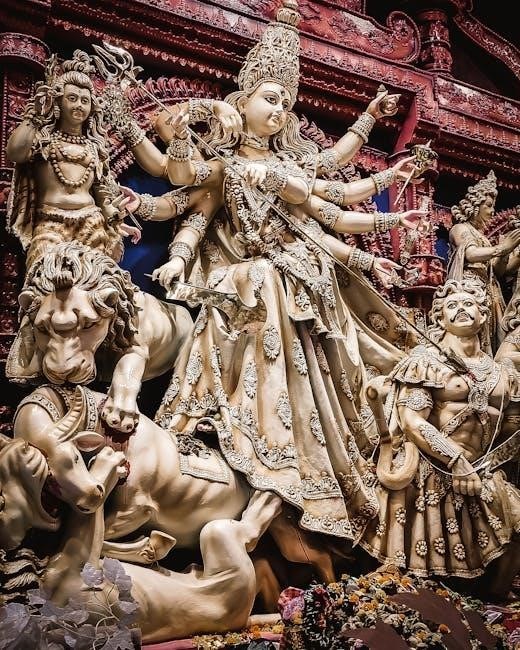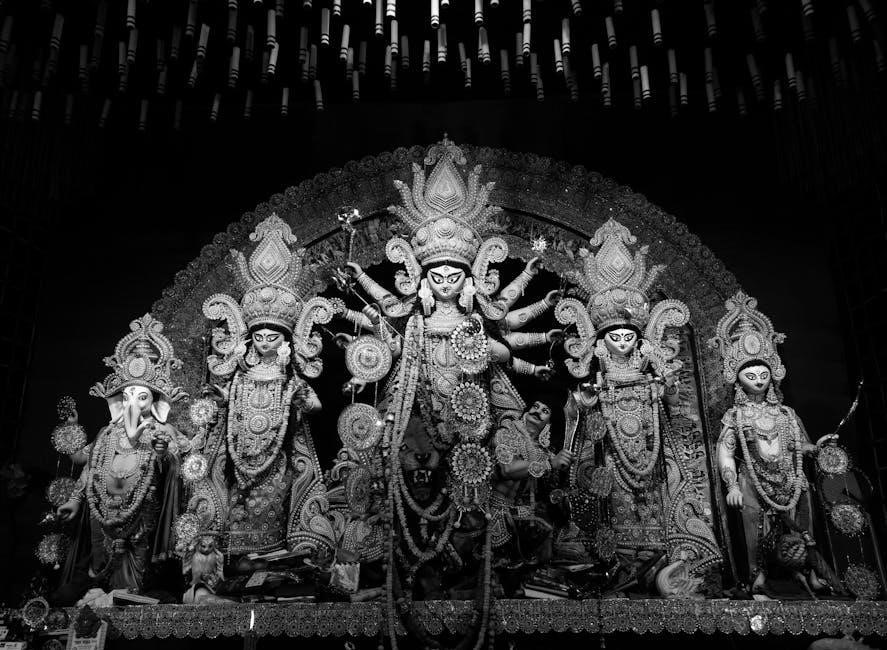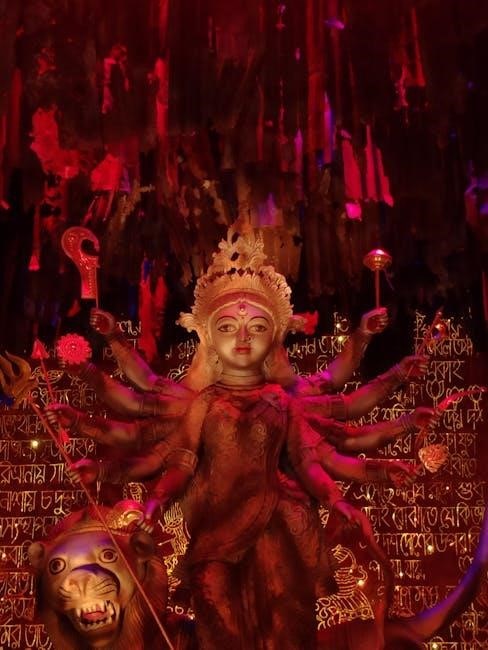Mahishasura Mardini PDF: An Overview
The Mahishasura Mardini Stotram‚ a revered hymn‚ is available in PDF format for easy access. It provides devotees with the lyrics and potential translations‚ enhancing spiritual practice during occasions like Navratri.
The Mahishasura Mardini Stotram‚ also known as Aigiri Nandini‚ is a popular Durga Devi hymn in Sanskrit. Composed by Adi Shankaracharya‚ it praises the goddess Durga’s victory over the demon Mahishasura. The Stotram is based on the Devi Mahatmyam and is often chanted during Navratri celebrations. It is a powerful prayer that invokes the blessings of the goddess and celebrates her divine powers and triumph over evil. Access to the PDF version facilitates wider distribution and easier recitation.

The Significance of the Mahishasura Mardini Stotram
The Mahishasura Mardini Stotram holds immense importance during Navratri. Composed by Adi Shankaracharya‚ it extols the powers of Devi. Reciting this stotram during Navratri amplifies its spiritual impact for devotees;
Navratri Celebrations and the Stotram
During Navratri‚ the Mahishasura Mardini Stotram resonates deeply within festive celebrations. As devotees immerse themselves in the nine-day festival‚ this powerful hymn amplifies the spiritual ambiance. The stotram’s verses‚ praising Goddess Durga’s triumph over the demon Mahishasura‚ beautifully blend with the traditional Navratri rituals. It enhances devotion‚ creating a profound connection between the celebrants and the divine feminine‚ enriching the festive experience.
Adi Shankaracharya’s Composition
Composed by the revered Adi Shankaracharya‚ around 810 AD‚ the Mahishasura Mardini Stotram holds a special place in Hindu devotional literature; Rooted in Devi Mahatmyam‚ the stotram beautifully captures the powers of Devi‚ making it a timeless masterpiece. Shankaracharya’s profound understanding of spirituality shines through each verse‚ inspiring devotees. His composition serves as a powerful tool for connecting with the divine‚ enhancing the stotram’s significance and enduring appeal.

Lyrics and Translations
Accessing the Mahishasura Mardini Stotram lyrics is simple‚ with English translations available. These resources enable devotees to understand and appreciate the stotram’s meaning‚ fostering a deeper connection during recitations and enhancing spiritual practice.
Availability of Lyrics in English
Devotees seeking to understand the profound meaning of the Mahishasura Mardini Stotram can readily find lyrics in English. Several online resources and archives offer accurate transcriptions‚ allowing individuals to connect with the hymn on a deeper level. These translations often include commentaries‚ providing valuable insights into the stotram’s verses. This accessibility ensures that non-Sanskrit speakers can fully appreciate the devotional piece‚ enhancing their spiritual experience and understanding of Devi Mahatmyam.
Commentary and Translations by Swami Kasikananda Giri
Swami Kasikananda Giri’s commentary and English translation of the Mahishasura Mardini Stotram are highly regarded resources for devotees. His work provides insightful explanations of the verses‚ enhancing comprehension and spiritual connection. The translations capture the essence of the stotram‚ allowing non-Sanskrit speakers to appreciate its beauty and depth. Available in PDF format‚ Swami Kasikananda Giri’s commentary offers a valuable tool for those seeking a deeper understanding of this powerful hymn and its significance.
Download Options and Accessibility
The Mahishasura Mardini Stotram is widely available for download‚ with the PDF format being the most common. This accessibility ensures devotees can easily access and use the stotram for personal or communal worship.
PDF Download Availability
The Mahishasura Mardini Stotram is readily available as a PDF download from various online resources. Many websites and online archives offer this format‚ allowing devotees to easily access the hymn on their devices. The PDF version often includes the original Sanskrit text‚ along with translations and commentaries. This accessibility makes it convenient for individuals to incorporate the stotram into their daily prayers and spiritual practices‚ regardless of their location or access to physical books‚ fostering a deeper connection with the divine.
Other Formats: EPUB‚ MOBI‚ and More
Beyond the popular PDF format‚ the Mahishasura Mardini Stotram is sometimes available in other digital formats to cater to different e-readers and devices. EPUB and MOBI files are common alternatives‚ offering reflowable text that adapts to various screen sizes. These formats are particularly useful for those who prefer reading on e-readers like Kindles or other mobile devices. While PDF remains widely accessible‚ the availability of EPUB and MOBI formats enhances the reading experience for users with specific preferences‚ ensuring broader accessibility of the stotram.

The Story Behind Mahishasura Mardini
The Mahishasura Mardini narrative centers on Goddess Durga’s triumph over Mahishasura‚ a powerful buffalo demon. This tale symbolizes the victory of good over evil and the divine feminine’s strength.
Mahishasura: The Buffalo Demon
Mahishasura‚ whose name combines “Mahisha” (buffalo) and “Asura” (demon)‚ was a formidable entity in Hindu mythology. Born from the union of a buffalo and an Asura‚ he possessed immense strength and the ability to shapeshift. His reign of terror threatened the gods‚ as he aimed to conquer the heavens‚ making him a powerful adversary whose defeat required divine intervention.
Durga’s Incarnation and Victory
To combat Mahishasura’s tyranny‚ the gods combined their divine energies‚ giving rise to Durga‚ a powerful warrior goddess. Armed with celestial weapons‚ she engaged Mahishasura in a fierce battle. After a prolonged conflict‚ Durga triumphantly slayed Mahishasura‚ restoring cosmic balance and earning the epithet “Mahishasura Mardini‚” the slayer of Mahishasura. This victory symbolizes the triumph of good over evil‚ celebrated through the ages.
Devotional and Spiritual Aspects
The Mahishasura Mardini Stotram serves as a powerful devotional tool‚ fostering spiritual growth and inner peace. Recitation during prayers and rituals amplifies its impact‚ connecting devotees with the divine feminine energy of Durga.
Usage in Prayers and Rituals
Devotees integrate the Mahishasura Mardini Stotram into their daily prayers and special rituals‚ especially during Navratri. Reciting or listening to the stotram is believed to invoke the blessings of Goddess Durga‚ offering protection and strength. Its verses resonate deeply‚ enhancing the spiritual atmosphere of worship. The stotram’s powerful vibrations are thought to purify the mind and soul‚ fostering a sense of devotion and connection with the divine.
The Stotram’s Impact on Devotees
The Mahishasura Mardini Stotram profoundly impacts devotees‚ instilling courage and devotion. Reciting the stotram is believed to remove obstacles and negativities‚ fostering inner peace and strength. Many find solace and inspiration in its verses‚ connecting deeply with Goddess Durga’s divine energy. It serves as a reminder of the triumph of good over evil‚ empowering devotees to overcome challenges and lead virtuous lives filled with devotion.
Different Languages and Scripts
The Mahishasura Mardini Stotram is accessible in various Indian languages and scripts‚ including Sanskrit‚ Malayalam‚ and more. This availability allows a broader audience to engage with and understand the stotram.
Availability in Sanskrit‚ Malayalam‚ and Other Indian Languages
The sacred Mahishasura Mardini Stotram resonates across India‚ available in diverse languages like Sanskrit‚ Malayalam‚ and others. This multilingual accessibility ensures that devotees from various linguistic backgrounds can connect with the hymn’s divine essence. Resources provide the stotram in multiple scripts‚ enhancing understanding and recitation‚ fostering a deeper spiritual connection. Versions cater to different regional preferences‚ making the hymn universally accessible.
Resources for Various Language Scripts
Devotees seeking to engage with the Mahishasura Mardini Stotram in their preferred language can find abundant resources online. Websites and archives offer the hymn in various Indian language scripts‚ including Sanskrit‚ Malayalam‚ Telugu‚ and more. These resources often provide transliterations and translations‚ aiding comprehension and accurate pronunciation. Such accessibility ensures wider participation in the stotram’s recitation‚ fostering a deeper connection with its spiritual significance.
Where to Find Mahishasura Mardini Stotram PDF
Finding a Mahishasura Mardini Stotram PDF is simple through online archives. These resources offer accessible downloads of the hymn. This allows devotees to easily engage with this sacred text.
Online Archives and Libraries
Several online archives and libraries offer the Mahishasura Mardini Stotram in PDF format. The Internet Archive hosts a version‚ allowing users to download the file freely. Vaidika Vignanam also provides the stotram in multiple languages‚ including English‚ with PDF options. These digital resources ensure the stotram is readily available for devotees and researchers alike‚ facilitating wider access to this significant devotional work and enabling its study and recitation across different linguistic communities.
Websites Offering PDF Downloads
Numerous websites provide PDF downloads of the Mahishasura Mardini Stotram. Bharatiweb.com offers the stotram for download‚ ensuring accessibility for devotees. Other platforms such as Vaidika Vignanam also host the stotram in various scripts and languages‚ along with PDF versions. These websites serve as valuable resources‚ allowing individuals to easily obtain and use the stotram for devotional purposes‚ study‚ and recitation‚ fostering a deeper connection with the divine.

Related Works and Authors
Several authors and related works delve into the significance of Mahishasura Mardini. S. N. SASTRI is one such figure‚ with works providing deeper insights into the stotram and its spiritual context.
Works of S. N. SASTRI
Shri S.N.Sastri‚ born in Kerala in 1922‚ had a distinguished career after graduating with a Mathematics degree. He joined the Indian Revenue Service in 1944 and eventually became a Member of the Central Board of Direct Taxes. His works offer valuable perspectives‚ potentially including interpretations of devotional texts like Mahishasura Mardini.
Other Commentaries and Interpretations
Alongside Swami Kasikananda Giri’s commentary‚ various scholars and spiritual leaders have offered interpretations of the Mahishasura Mardini Stotram. These commentaries provide deeper insights into the hymn’s meaning‚ symbolism‚ and significance. Exploring different interpretations can enrich one’s understanding and appreciation of this powerful devotional work‚ offering varied perspectives on its spiritual message and cultural context.







